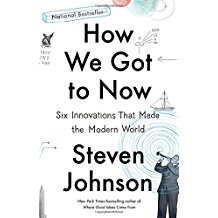How We Got to Now: Six Innovations that Made the Modern World, Steven Johnson, 2014
Johnson chooses six innovations that account for much of the progress over the last two centuries: glass, electric light, indoor plumbing and clean water, refrigeration, sound recording and amplification, and clocks and uniform systems of time. He promotes the hummingbird theory based on the unique evolutionary design of the hummingbird’s flight that enables the bird to hover in order to drink nectar, a secondary outcome of the evolution of plants to meet their need for pollination. In the same way, Johnson argues, innovations such as the printing press led to the discovery that many people were far-sighted and needed spectacles which led to the development of glass lenses which led to the telescope and microscope which led to the confirmation of the germ theory which led to chlorination of water and development of urban sewer systems which enabled the growth of cities beyond a formerly limiting size, etc, etc. He proposes the step wise, group theory of discovery rather than the isolated Eureka moment in the myth of Edison and the light bulb pointing out that there were dozens of patents for electric lights before Edison’s own. His chapters on how keeping track of time moved from the sun to the pendulum clock to the quartz based timepiece to the atomic clock measuring the movement of electrons in Cesium 131 is one of the best, ultimately tying it into the need for uniform time for railroads in the US and the adoption of our current four time zones. Quickly moving, informative, and entertaining, this is a fine book for anyone interested in science, technology, and history.



